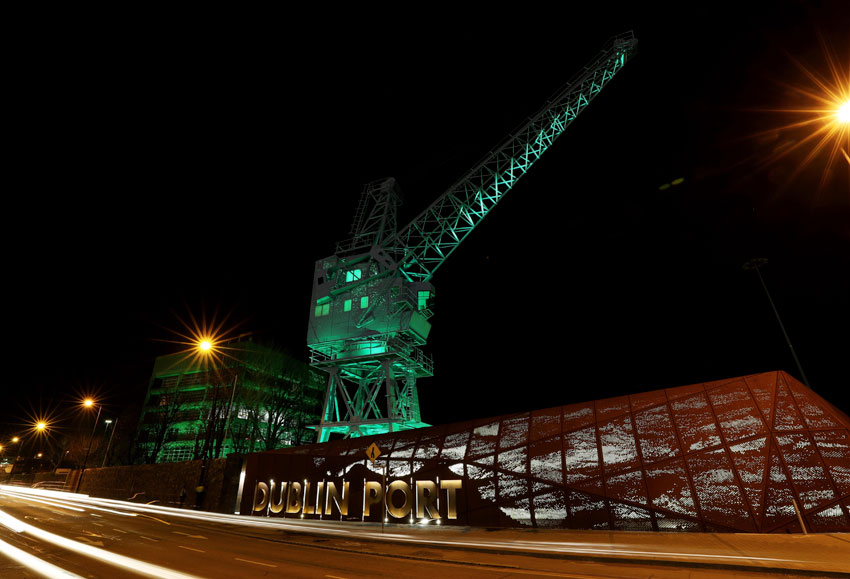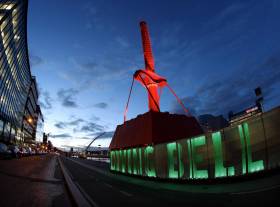Displaying items by tag: St Patrick's Festival
Waterways Ireland Partners With St Patrick’s Festival to Celebrate Beloved Dublin Canals
This year, Waterways Ireland’s partnership with the St Patrick’s Festival will celebrate the beloved Dublin canals as one of 10 showpiece performances in the capital’s St Patrick’s Day Parade on Friday 17 March.
With half a million spectators expected to line this year’s route, the cross-border body for Ireland’s inland waterways says it’s proud to showcase and celebrate the history, heritage and recreational vibrancy of the Dublin canals as integral parts of Ireland’s culture.
As the parade passes by look out for ‘Uiscebhéal’, a performance inspired by the values of sustainability and community that will highlight the role of the Grand Canal and Royal Canal in the life of the city.
John McDonagh, Waterways Ireland chief executive said: “Our treasured historic canals are familiar welcoming places for generations, spaces for recreation, inspiration for artists and a sanctuary where nature can survive and thrive.
“It is a pleasure to have worked with the St Patrick’s Festival team to recognise the significance of the Royal and Grand canals in Dublin through this wonderful performance.”
Richard Tierney, St Patrick’s Festival CEO added: “Our partnership with Waterways Ireland celebrates some of the most intrinsic and loved parts of Dublin and Ireland, we are thrilled to shine a light on the usage of the canals and the many ways we can all enjoy these great amenities.”
The St Patrick’s Festival takes place in Dublin and nationwide from Thursday 16 to Sunday 19 March.
First-Ever Floating Pageant Part of Waterways Ireland’s Partnership With St Patrick’s Festival 2022
Waterways Ireland has announced details of its partnership with the St Patrick’s Festival that will see, for the first time in the festival’s history, a floating pageant in the annual St Patrick’s Day parade.
Supported and inspired by Waterways Ireland, the installation will be on the River Liffey near O’Connell Bridge in Dublin city centre as a key feature of the parade on Thursday 17 March.
The festival’s creative team has designed the floating water garden as a visual interpretation of the biodiversity and sustainability of Ireland’s inland waterways.
In keeping with the overarching theme of this year’s festival, ‘Naisc/connections’, the floating garden shows how the physical waterway network connects Dublin to the rest of Ireland.
It will celebrate the inland waterways; the unrivalled access they give to our cultural and natural heritage and the network of towns and villages that line the banks; the connectivity between people who love, protect, and enjoy the lakes, rivers, and canals, managed by Waterways Ireland; and the connection to the outdoors.
Speaking at the announcement today, Thursday 3 March, Waterways Ireland chief executive John McDonagh said: “We are thrilled to have this wonderful opportunity during the St Patrick’s Festival to celebrate our waterway network in the capital city and its links to hundreds of communities across the island.
“Many of our poets, artists and lovers of heritage, nature and culture have drawn inspiration from the Royal and Grand canals. Reaching out to our communities in Ireland and abroad to share our story of the unexplored outdoors is the very essence of Waterways Ireland and well captured by the festival organisers through this innovative floating pageant.”
For more on events during the St Patrick’s Festival this month, visit stpatricksfestival.ie.
Dublin Port Landmarks To ‘Go Green’ For St Patrick’s Day
Dublin Port’s iconic landmarks are set to be illuminated in green for the first time to celebrate the St Patrick’s Festival next week.
The Diving Bell on Sir Rogerson’s Quay, Port Centre and Crane 292 will be aglow in emerald for the duration of the festival from Thursday 15 to Monday 19 March at dusk each evening.
And they will be in illustrious company as each year global landmarks show their St Patrick’s Day spirit by going green.
This year over 300 stadiums, statues, museums and towers will take part, including the Colosseum in Rome, Sydney Opera House and Niagara Falls — not to mention the GPO, Kilkenny Castle and the Rock of Cashel closer to home.
Speaking on its inclusion in the St Patrick’s Festival, Dublin Port Company chief executive Eamonn O’Reilly said: “Usually blue is our favourite colour at the port but we’re keen to go green next week.
“The inclusion of these iconic port landmarks is of special significance for us as port city integration is at the core of everything we do. There is a shared history, culture and community between the port and our capital city.
“We hope that people enjoy our contribution to this year’s festival and come to see some fantastic port landmarks in a new light.”

Susan Kirby, CEO of the St Patrick’s Festival, added: “It’s wonderful that Dublin Port is greening the new Port Centre plaza and two of its heritage sites and that it is also part of our artistic programme for this year’s St Patrick’s Festival programme. Dublin Port is a part of our capital city which is steeped in history and has some fantastic stories to tell.
“I would encourage anyone who wants to learn a little more about the port and the shipping industry to download and enjoy the Port Walks podcast walking tour which is engaging and enlightening in equal measure and provides some fascinating insights.”
The landmarks included in the festival are also part of Dublin Port Company’s developing heritage trail, which follows a path along the River Liffey from the Diving Bell via Grand Canal Dock and onward towards North Wall Quay Extension across the East Link bridge to Port Centre on the East Wall Road.
Port Centre precinct has recently undergone redevelopment and is now open to the public with a new public plaza featuring a maritime garden with seats for reflection and relaxation and a sculptural sphere which echoes the time ball of the old Ballast Office.
The port is encouraging members of the public to share their images of these three landmarks lit up on social media with the hashtags #globalgreening #DublinPortCentre #DublinPortCrane #DivingBell and #StPatricksFest.
French Frigate on Festival Visit to Dublin
#FrenchFrigate –French anti-submarine frigate De Grasse (D 612) is currently on a courtesy call to Dublin Port, having arrived yesterday for the St. Patrick's festival weekend, writes Jehan Ashmore.
A crew of more than 200 operate the 4,650 tonne displacement vessel which is based in Brest, where she is primarily deployed on operations along the Atlantic front.
The frigate was built in 1972 and entered service five years later. Among her armoury are 6 Exocet MM 38 missiles and there is a 155m² helicopter hanger, where she can carry up to two Lynx helicopters.
De Grasse is moored at Ocean Pier (berth 35) which is nearly opposite the Poolbeg Yacht & Boat Club Marina, Ringsend. She is scheduled to remain in port until Tuesday morning.































































